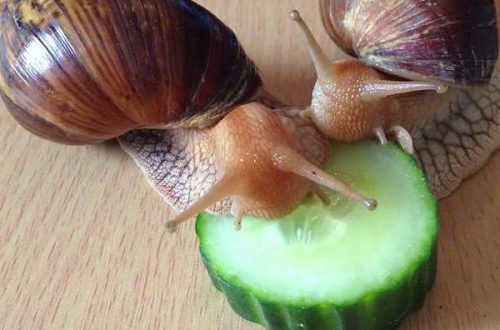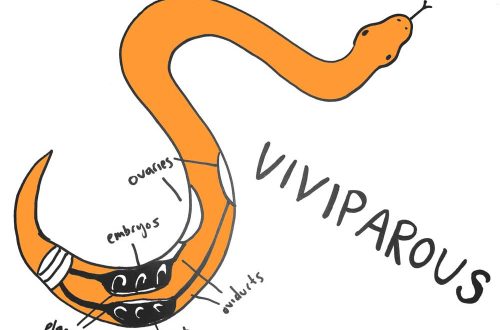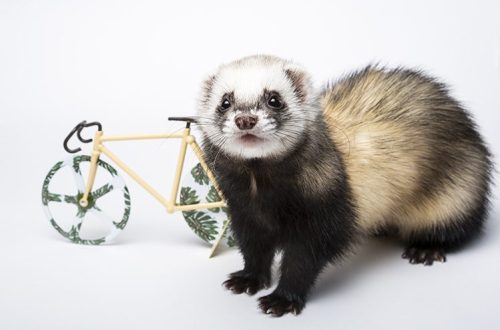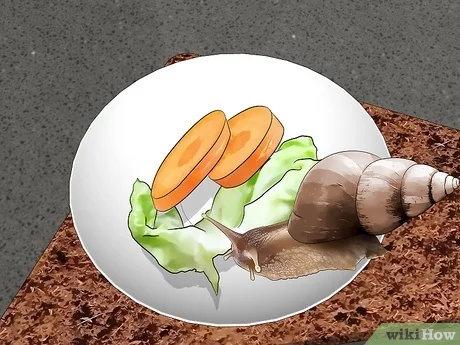
ខ្យងដីដែលផលិតនៅផ្ទះ៖ ប្រភេទ និងលក្ខណៈពិសេស ការថែទាំ ការថែទាំប្រចាំថ្ងៃ អាហារូបត្ថម្ភ និងដំបូន្មានអ្នកជំនាញ
Land snails are pretty, unpretentious and economical creatures, the breeding of which at home is a very popular activity in our time. This is explained by the fact that the content of the land snail does not require large financial costs and special care.
These gastropods can be safely left at home alone, leaving for a long time on vacation or a business trip. They do not need walks and periodic trips to the vet. Wildlife lovers enjoy watching their very interesting life with great pleasure. Since domestic snails are hypoallergenic, for the most part they cannot become carriers of the disease and various parasites.
មាតិកា
Types of land snails
As pets, the largest and most diverse domestic snails, Achatina, are best suited.
Achatina reticulum – a very curious and mobile species of domestic snails. She is very interested in the environment and in order to be aware of everything that is happening, she often raises her head. The color of the head and neck is brown or black, the border of the legs is light. The shell is “painted” with dots or stripes. Unlike its relatives, the reticulum grows very quickly. The shell diameter reaches 20 cm. They are unpretentious in care, they eat everything. Them easy to feed by the hour. In captivity, they can lay up to 300 eggs.
Achatina fulica – the laziest representative of the Achatina family, spends most of the time at rest. it very large snail, the color of the shell can be black, red, brown, its size reaches 20 cm. At home, it lives up to 6 years, actively breeding.
Achatina the Immaculata. The coloring is very varied. It is distinguished from other representatives of the Achatina genus by a pinkish or light purple rim along the shell and a characteristic pink stripe on the head and neck. In laying – 15-200 eggs.
Achatina albopicta. It has some resemblance to the reticulum, but smaller (up to 16 cm). The tip of the shell is pink, the rim of the shell is white or yellowish. Unpretentious, but a little voracious. Can bring offspring up to 300 small individuals.
Achatina iradeli. Due to the characteristic yellowish color, it is also called “lemon”. This is a very small snail, only 5-7 cm in size. It is unpretentious in content, like its relatives, but has a very interesting difference.: this is the only Achatina that does not bring eggs, but live cubs (20-25 individuals).
Achatina brown. It looks like a fulica, differs only in the shape of the shell: the fulica has a cone-shaped shell, without roundings, and the shell of the brown Achatina is semicircular. It is sociable in nature, unpretentious in content. Like other snails of the Achatina genus, it is very prolific.
Achatina vulgaris. Huge size snail, brindle colors. In nature, its shell reaches a length of 30 cm. Domestic Achatina ordinary has a more modest size (up to 22 cm). The color is orange or light yellow, the stripes on the shell are black or brown. Dark colored legs. At home, they live up to 7 years. The character is calm, in his free time from eating he prefers to rest in his mink.
Another type of domestic snail that is popular with breeders is grape snails. From Achatina they are much smaller(5 cm long, 4,5 cm wide), their colors are very diverse.
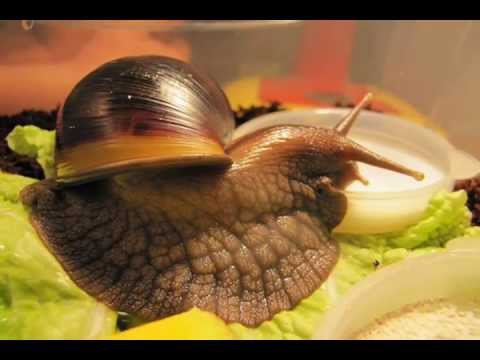

មើលវីដេអូនេះនៅលើ YouTube
Keeping land snails
It is necessary to purchase a special terrarium, on the roof of which there should be small ventilation holes so that the snail cannot get out of its home by itself. A layer of specially treated earth or coconut substrate is placed on the bottom, used as soil. The thickness of the layer depends on the size of the gastropod so that during the daytime sleep the snail can completely dig into the ground. Necessary រក្សាដីឱ្យមានសំណើមspraying it with water once a day. In no case do not allow waterlogging of the flooring!
The volume of the terrarium must be at least 10 liters per individual. The temperature inside must be maintained at 25-27 degrees (depending on the type of snail). For heating, it is better to use external heat sources (thermal cords or thermal mats), since heaters located inside the terrarium can cause severe burns to its inhabitants. Incandescent lamps can also be used as a heat source, after closing the pets from the light. In no case do not put the terrarium on the windowsill: the bright sun can interfere with the snail’s daytime rest, and also heat up its dwelling greatly. Another danger is drafts. Snails can freeze slightly, because the temperature is below + 18-20 degrees – it is already cold for them.
A snail aquarium can be greened up by planting non-toxic plants, such as lettuce or cat grass. Sphagnum moss (sold in a flower shop), coconut shell, various snags from a pet store or from the forest (necessarily well processed) are used as decorations.
The bowl for food should be made of soft material (you can use polyethylene lids for jars). There should not be any glass, metal, ceramics in the terrarium! Snails do not need a light, so you can turn it on only if you want to watch your pets.
Once a day, the walls of the terrarium must be wiped with a damp cloth, without the use of chemicals, as they can cause severe burns. It is allowed to use ordinary soda, which then must be thoroughly washed off. General cleaning should be carried out every week. To wash the terrarium and the dishes in it, there should be a separate sponge.
Land snails love to take a bath. To do this, you can put them in a shallow bowl of water or put them under a stream of warm water (not hot!). While bathing clean the sink thoroughly from adhering dirt with a soft brush.
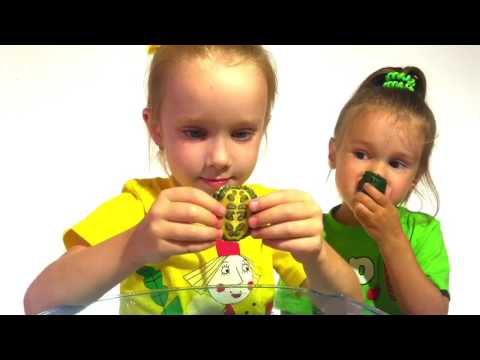

មើលវីដេអូនេះនៅលើ YouTube
Food of land snails
As a rule, snails are fed once a day – in the evening. Plant foods form the basis of their diet. They with great pleasure absorb various greens, vegetables, fruits.
របបអាហារប្រហាក់ប្រហែល
Lettuce leaves can be placed directly on the ground and used simultaneously as a plate for vegetables, fruits and the food itself.
Sepia. In the terrarium there should always be a piece of cuttlefish shell, which is gradually gnawed by snails.
Dry mixture consisting of: ground grain mixture and calcium (eggshell, river shell rock, fodder chalk, etc.). All this is necessary for the proper development and strength of the shell.
ផ្លែឈើនិងបន្លែ:
- carrots, pumpkin, zucchini, cucumbers;
- bananas (or their skins), avocados, mangoes, apples, pears.
ផ្លែឈើនិងបន្លែរឹង pre-crushed with a grater, soft – cut into small pieces.
Vegetable puree, prepared by you or bought in the store (children’s, without salt!). Puree can be mixed with grain mixture and calcium, given in the form of porridge.
Several times a week, snails need to be offered food with a high protein content:
- សាច់សុទ្ធ;
- អាហារសមុទ្រ;
- daphnia;
- food for fish.
In no case should you feed the gastropods with salty foods, since salt is a terrible poison for them!
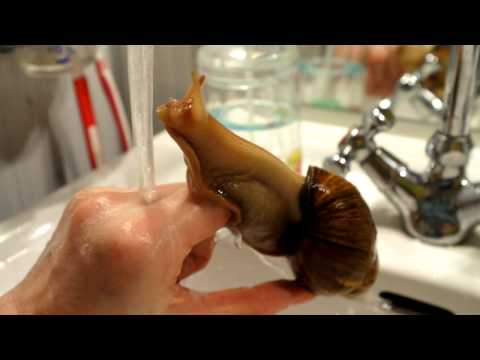

មើលវីដេអូនេះនៅលើ YouTube
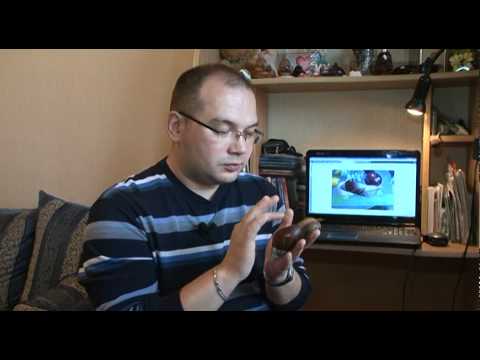

មើលវីដេអូនេះនៅលើ YouTube
ការថែទាំប្រចាំថ្ងៃ
Collect the leftovers of the meal to prevent them from rotting and, as a result, the appearance of midges and mold.
Collect feces not only on the surface of the soil, but also inside.
Spray the soil (as needed), the walls of the terrarium and the snails themselves.
Care must be taken when removing the snail from the wall: in no case pull it by the sink! You can remove it like this:
- spray the wall with water;
- snail and your hand, carefully slide your finger under the pet’s head;
- gently lift and unstick.
Land snails are sweet, good-natured and very cute creatures. Settling in your home They are sure to become family favorites. អស់រយៈពេលជាច្រើនឆ្នាំ។


មើលវីដេអូនេះនៅលើ YouTube





